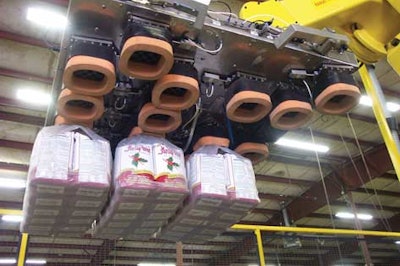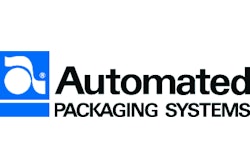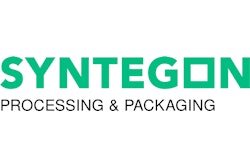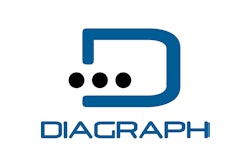The Espoma Company is reportedly the first in North America to use the U-Pack™ package for its 4-, 5-, and 10-lb bags of plant food (shown below). From Bischof + Klein, the premade bags have been used in Europe and the Far East for pet food and treats, and for coffee.
At Espoma, these plastic bags replaced paper versions last year, allowing bags to be merchandised outside with the plants and flowers they help grow. The switch to plastic led to the company’s acquisition of new and more efficient packaging equipment highlighted by a robotic palletizing system from Automated Production Systems. The robotic system handles output from three packaging lines, two of which produce 25-, 35-, and 50-lb plastic bags. The third line, Espoma’s newest and most automated, produces the plastic-bundled U-Pack bags. Equipped with a Fanuc articulating arm, the robotic system also picks and places pallets and slip sheets as necessary.
The new line includes a modified filler from Parsons-Eagle, a new SIG Doboy top sealer, and a new stretch-wrap bundling machine made by Hagemann in Germany. Hagemann is represented in the United States by BC Technologies.
Recognizable bags
The bags are recognizable by their two side gussets and flat, square bottom. To make the U-Pack, B+K first manufactures the film. It reverse-prints an outer polyester layer flexographically in six colors. Separately, it adhesive-laminates the printed film to an inner polyethylene sealant layer. The overall structure is 4.5 mils for the 4- and 5-lb bags, 5.25 mils for the 10-lb size. B+K then uses new bag-making equipment to fabricate the bags. The company prefers not to identify the equipment maker. Bags are made in four different dimensions for the three different product weights to accommodate differences in density. The dimensions range from 51?2”Wx31?8”Dx141?4”H to 7”Wx41?2”Dx163?4”H. Espoma uses the U-Pack for 33 different stockkeeping units.
For the 75-year-old Millville, NJ-based, fourth-generation family business, graphics for the new bags create a “family” design that brings all the company’s products under one design created for the recent change from paper to plastic bags. “We’re in the specialty and premium end of the lawn and garden business,” explains Serge Brunner, Espoma’s vice president. “We believed our previous bags had equity, good customer recognition, and loyalty. Yet, we wanted to upgrade bag graphics and add marketing appeal.”
Jeremy Brunner, Serge’s son and the company’s general manager, says that Espoma worked on graphics with an agency called Eggz. Specifically, he says, “the Espoma logo with a grouping of flowers is now used as a banner for all of our premium-blend Tone products. They’re also used for two other product lines: Organic Traditions for anything that’s natural or organic, and Quick Solutions for products that use fast-acting synthetic nutrients. The changes made it easier for consumers to understand that the three product lines are different, but are part of one family.” Last year, Espoma completed a three-year transition to plastic by converting all of its small bags to the U-Packs.
Although Espoma changed graphics and bag material, it wanted to maintain the previous paper bag’s flat bottom and side gussets, which yield more space for copy. “We were one of the first companies to use these bags,” Serge Brunner recalls.
“We not only liked the bag style, but we also had the equipment set up to package it,” says Jeremy Brunner. “Once we started a search for a plastic bag that was similar to our paper bag, the options narrowed quickly. We discovered B+K through your magazine,” he says during a recent Packaging World visit. “It was a perfect match because we needed the bag and B+K was looking to [introduce the bag commercially] in North America. B+K had a lot of experience with this style of bag in Europe. So we hooked up with them.”
Equipment changes
Before adding the new equipment for the U-Pack bags, Espoma’s small-bag packaging process hadn’t changed much for about 60 years, with seven people used to package 10 bags/min in a semi-automatic process. The Parsons machine, added in the ’90s, runs 50 small bags/min, 25 each per redundant fill head, regardless of bag size. The redundancy means that even if one side requires maintenance, the 25/min rate on the other side would more than meet the company’s goal.
To accommodate the plastic U-Packs, minor modifications were made in the machine’s two bag magazines that enable mechanical picker heads with vacuum cups to more easily grab the individual bag and place it under the filling station. The two in-line filling stations are mounted a few feet apart. At each of the two filling stations, opener arms, also equipped with vacuum cups, open the bag for filling.
Once the bags are filled, the vacuum is turned off and the bags are gently dropped a few inches onto a discharge conveyor. The conveyor vibrates while side belts hold the bags in place as they are conveyed downstream. The vibration helps the bags regain their square shape, which tends to round out at the bottom after the product fill.
Sealing and bundling
Bags are conveyed single-file through the SIG Doboy S-CH-S, a high-speed, continuous band sealer. As bags enter the infeed of the machine, they’re held upright by timing belts. Bags pass between a pair of Teflon-coated fiberglass bands that heat seal the top. Compression rollers pinch the bag top together before the bag passes through a set of cooling bars that lower the temperature in the seal area.
Sealed bags continue on a conveyor to the new Hagemann TTP 762 stretch-wrap bundler, which first collates the U-Packs, then stretch wraps 4- and 5-lb bags into bundles of 12, or 10-lb bags into bundles of six.
Although Espoma markets the bags by weight, the fill level in each bag varies, depending on the product. To accommodate these differences, the Doboy has a plastic cover whose height is adjustable based on bag height and product differences.
As bags are conveyed into the machine, they contact a pair of parallel stainless-steel bars that roll back the sealed top. The plastic cover prevents the bag top from popping back to its upright position. That’s important for creating a tight, compact bundle downstream.
Before reaching the wrapping station, bags are conveyed into the machine, stopping when they contact a plow. The plow retracts after two bags reach that point, and a pusher device moves the two bags onto a perpendicular conveyor, on a grouping plate. Here, bags are positioned into a 2x3 or 3x4 configuration, depending on bag size.
Another plow pushes the group of bags into a wrapping station. Throughout the machine, the plastic cover continues to hold down the bag tops. In the wrapping station, a roll of clear plastic film mounted above the conveyor is prestretched 150%. Espoma is still testing films to determine what film would work best with the different pack sizes. At this point, the company is using both a 120-ga low-density polyethylene blown film, and a 135-ga linear LDPE film. The orbital wrapper is equipped with a latching mechanism that holds the leading edge of the film. The servo-driven Hagemann uses a pusher and side conveyor belts to tightly hold the group of bags.
The orbital wrapper revolves around the bundle, applying three wraps around each bundle. The film is manufactured with tack on one side so that each layer sticks to itself, but not to the bags. After the last wrap, a knife on the latching mechanism cuts the film, while holding the trailing edge for the next wrap. The wrapped bundle, with a bull’s-eye at each end that allows for manual handling, is discharged onto a conveyor. It then goes through two hot-air blowers that help make the bundle even tighter.
The bundle is then conveyed through a Diagraph print-and-apply unit. The thermal-transfer printer prints the company name, product type, and a UPC bar code, all in black, onto a 4”x81?8” label. The label is tamped onto the top edge of the bundle. The portion of the label that hangs over the bundle’s edge is blown onto the bundle’s side.
Unique robotic process
From the labeler, bundles of the U-Pack bags are conveyed to the robotic palletizer. Filled bags are also conveyed to the fenced-in palletizing area from the two lines that produce the larger 25-, 35-, and 50-lb bags.
The multiline robotic palletizing system keeps recipes of each of Espoma’s packaged product in a PLC. Product from each of the three lines enters on an infeed conveyor where devices turn bags or bundles as necessary to form a layer that is picked up by the Fanuc robot. At the end of the robot is the customized APS end-of-arm tooling. Approx-imately 40”x48”, the tooling uses vacuum to pick up a layer of bundles, bags, or a slip sheet. Pallet hooks are used to pick up pallets. The tooling uses multiple vacuum zones to do the picking and placing, turning different zones on or off depending on the recipe.
“We broke ground in our industry with this palletizing system,” Serge Brunner believes. “Nobody’s using robots in our business.” The company’s decision to move from manual to automated palletizing was made to eliminate the labor costs of five people—and other temporary hires during peak demand season—and the wear and tear it took on the people who performed those tasks.
During its search to find automatic palletizing equipment, Espoma expected to purchase a more traditional layer-forming machine to handle its high-speed line. “We said we’ll solve the problem with labor and keeping up with the new higher-speed line, then when we had the resources we could come back and solve the other two lines,” says Serge.
“We had made an appointment with Bill Donahue at Automated Production Systems,” he continues. “They were explaining their robots, but their cycle times seemed relatively slow. But the way they gain speed is by making multiple picks. The machine picks one layer at a time rather than one bag at a time and can work on three pallets simultaneously. APS showed us a video of the work they had done with McCormick’s spices. What caught my eye was that one robot was handling multiple lines simultaneously.
“This equipment allowed us to wipe out the labor problem for palletizing on all three lines. So we added the unit and have room next to it to add another robot if we need it in the future,” says Serge.
Palletized loads are conveyed out of the APS robotic cell in three lanes that merge into a single line that feeds into an older semi-automatic stretch wrapper prior to warehousing. “Bags are flexible and sometimes sloppy to palletize,” says Serge Brunner, “yet APS never left our side during the process.”
Payback
Since installing the equipment, productivity is up, while labor costs have dropped substantially. “We eliminated five men palletizing for three lines total: two on the high speed, two on the medium speed, and one on the semi-automatic line,” says Serge. But the company says it’s too early to estimate payback on the line.
“We have the same crew size today as we did decades ago, but we’re doing a lot more production,” he continues. “Automation has allowed that. We never fired anybody as a result of our automation. We’ve shifted them from production to receiving, shipping, maintenance, or other operations tasks.”
What also complicates payback is that the equipment runs on one shift, five days per week for only 10 months a year. Production is stopped during July and August for plant and equipment cleaning and maintenance. “So if we were a three-shift, year-around operation, calculating payback would be a breeze, but we’re a seasonal business,” says Jeremy.
Serge Brunner says the new plastic bags have resulted in “double-digit sales increases.” And he knows it wouldn’t have been possible without the equipment. “We have never compromised on the quality of our capital investments. Today, we believe we have the most modern, state-of-the-art fertilizer manufacturing and packaging system in the country. This equipment will provide us with the capacity and turnaround time to last us well into the 21st century.”


























